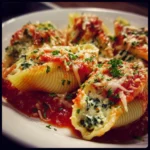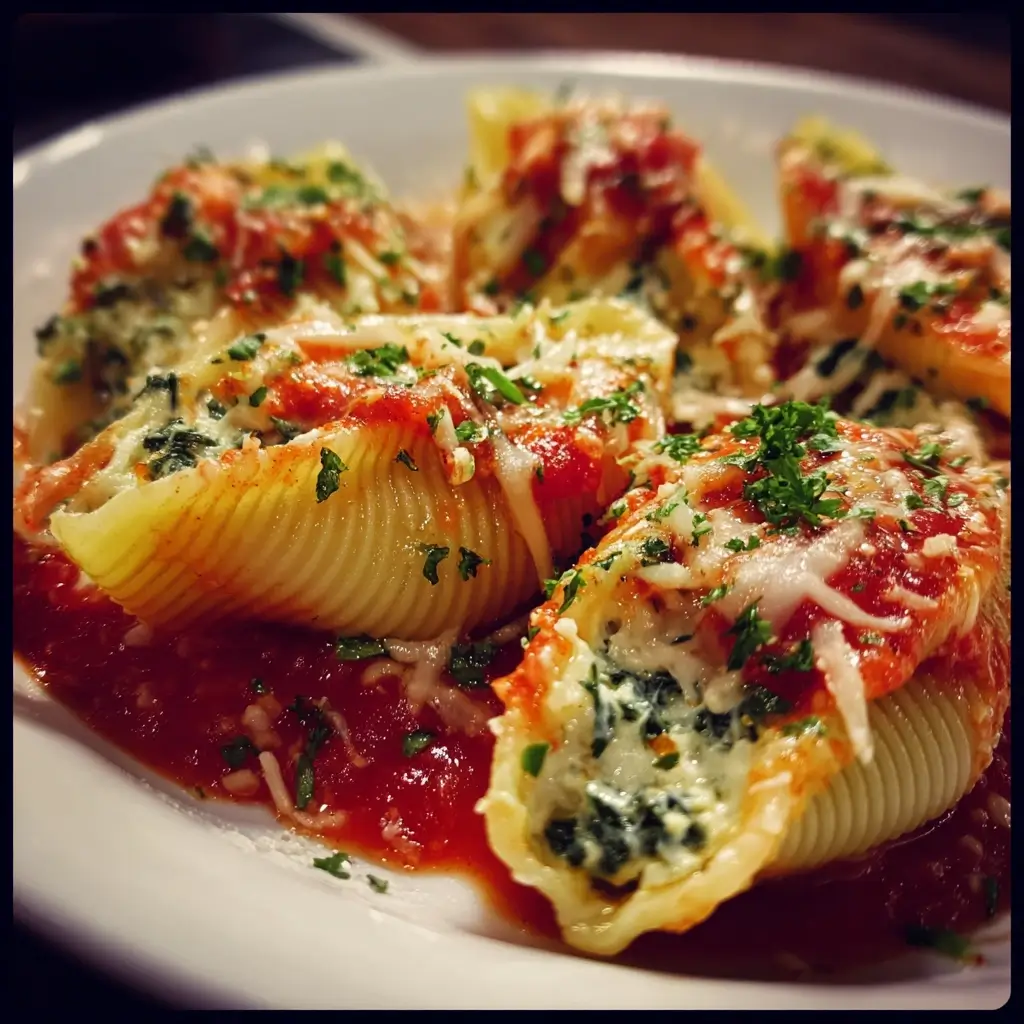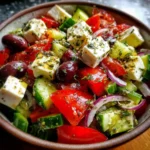Of all the dishes in my culinary repertoire, the one that consistently brings my family running to the dinner table with unparalleled excitement is this Stuffed Shells Vegetarian Recipe. There’s a certain magic in the way the kitchen fills with the warm, inviting aroma of bubbling marinara, melting cheese, and savory herbs. I remember the first time I made it for a Sunday dinner; the skepticism on my kids’ faces when they heard “vegetarian” quickly dissolved into wide-eyed delight at the first bite. The shells, perfectly cooked and generously filled with a creamy, three-cheese and spinach mixture, are nestled in a rich, tangy tomato sauce and blanketed with a golden, bubbly layer of mozzarella. It’s more than just a meal; it’s an event. It’s the ultimate comfort food, a dish that feels both elegant enough for guests and cozy enough for a quiet night in. Seeing the pan scraped clean, with everyone asking for just one more shell, is the highest compliment a home cook can receive. This recipe isn’t just about feeding people; it’s about creating a moment of pure, unadulterated comfort and joy.
Ingredients
- Jumbo Pasta Shells (12-ounce box): These are the vessel for our delicious filling. You’ll need about 24-30 shells, but it’s wise to cook the whole box as some will inevitably tear or break during the cooking process.
- Whole Milk Ricotta Cheese (32 ounces): This is the heart of our creamy filling. Using whole milk ricotta is non-negotiable for the richest, most luscious texture. It provides a sweet, milky base that perfectly complements the other cheeses and spinach.
- Shredded Low-Moisture Mozzarella Cheese (2 cups, divided): We’ll use this both in the filling for that classic cheesy pull and on top for a beautiful, golden-brown crust. Low-moisture mozzarella is key to avoid a watery result.
- Grated Parmesan Cheese (1 cup, divided): For a sharp, nutty, and salty kick. A good quality Parmesan, freshly grated if possible, will elevate the flavor profile of both the filling and the topping.
- Frozen Chopped Spinach (10-ounce package): Once thawed and squeezed bone-dry, spinach adds a wonderful earthy flavor, a pop of color, and a boost of nutrients. Squeezing out all the excess water is the most crucial step to prevent a watery filling.
- Large Egg (1): This acts as a binder, helping the cheese filling hold its shape beautifully inside the shells while baking, ensuring it doesn’t ooze out.
- Fresh Parsley (1/4 cup, finely chopped): Adds a bright, fresh, and slightly peppery note that cuts through the richness of the cheese. You can substitute with 1 tablespoon of dried parsley if needed.
- Fresh Basil (2 tablespoons, finely chopped): Provides that classic, sweet Italian aroma and flavor that pairs perfectly with tomato and cheese. If using dried, use 2 teaspoons.
- Garlic Powder (1 teaspoon): A convenient way to infuse a gentle, savory garlic flavor throughout the entire cheese mixture.
- Onion Powder (1/2 teaspoon): Adds a subtle, sweet, and savory depth to the filling that complements the garlic.
- Salt (1 teaspoon, plus more for pasta water): Essential for seasoning the pasta water and for bringing out all the individual flavors in the cheese filling.
- Black Pepper (1/2 teaspoon, freshly ground): For a touch of warmth and spice. Freshly ground pepper offers a much more potent and complex flavor than pre-ground.
- Your Favorite Marinara Sauce (48 ounces): A high-quality store-bought marinara sauce saves a lot of time and works wonderfully. Choose one with a rich tomato flavor and simple ingredients. You can, of course, use your favorite homemade sauce.
Instructions
- Preheat and Prepare the Pan: Begin by preheating your oven to 375°F (190°C). Spread about 1 ½ to 2 cups of your marinara sauce evenly across the bottom of a large 9×13-inch baking dish. This sauce layer is crucial as it prevents the pasta shells from sticking to the pan and infuses them with flavor from the bottom up as they bake.
- Cook the Pasta Shells: Bring a large pot of water to a rolling boil. Be generous with the salt; the water should taste like the sea. This is your only chance to season the pasta itself. Carefully add the jumbo shells to the boiling water and cook according to the package directions until they are al dente. This is very important—the shells should still have a firm bite, as they will continue to cook in the oven. Cooking them too long will result in mushy, difficult-to-fill shells. Once al dente, carefully drain the shells using a colander and rinse them gently with cool water to stop the cooking process and make them easier to handle. Lay them out in a single layer on a baking sheet to prevent them from sticking together while you prepare the filling.
- Prepare the Spinach: While the pasta is cooking, focus on the spinach. If you haven’t already, thaw the frozen spinach completely. Place the thawed spinach in the center of a clean kitchen towel, cheesecloth, or several layers of heavy-duty paper towels. Gather the ends and twist, squeezing out as much liquid as you possibly can over the sink. You will be amazed at how much water comes out. This step is the secret to a thick, creamy filling, not a watery, disappointing one. The goal is to have a dry, crumbly ball of spinach.
- Create the Creamy Ricotta Filling: In a large mixing bowl, combine the 32 ounces of whole milk ricotta, 1 cup of the shredded mozzarella, and ½ cup of the grated Parmesan cheese. Add the large egg, the thoroughly squeezed spinach, the chopped fresh parsley and basil, garlic powder, onion powder, 1 teaspoon of salt, and ½ teaspoon of black pepper. Using a sturdy spatula or wooden spoon, mix everything together until it is thoroughly combined. The mixture should be thick, creamy, and speckled with green from the herbs and spinach. Take a small taste and adjust the seasoning if necessary.
- Stuff the Shells: Now for the fun part! Using a small spoon or a piping bag (a zip-top bag with the corner snipped off works great for a cleaner, faster process), generously fill each cooked and cooled pasta shell with the ricotta mixture. Don’t be shy with the filling; each shell should be plump and full. As you fill each shell, nestle it, opening-side up, into the layer of sauce in your prepared baking dish. Arrange them in a single, snug layer.
- Assemble for Baking: Once all the shells are filled and arranged in the dish, pour the remaining marinara sauce over and around the shells. Try to cover as much of the pasta as possible to keep it from drying out in the oven. Finally, sprinkle the remaining 1 cup of shredded mozzarella and ½ cup of grated Parmesan cheese evenly over the top of the entire dish. This will create that irresistible, golden, and bubbly cheese crust.
- Bake to Perfection: Cover the baking dish tightly with aluminum foil. This traps the steam and helps the shells cook through evenly without the cheese on top burning. Place the dish in the preheated oven and bake for 30 minutes.
- Golden and Bubbly Finish: After 30 minutes, carefully remove the aluminum foil. Return the dish to the oven and bake for another 15-20 minutes, or until the cheese is completely melted, golden brown in spots, and the sauce is bubbling vigorously around the edges.
- Rest and Serve: Remove the stuffed shells from the oven and let them rest on a wire rack for at least 10-15 minutes before serving. This crucial resting period allows the filling and sauce to set, making the shells easier to serve and preventing them from falling apart. Garnish with a sprinkle of fresh chopped parsley or basil for a pop of color and freshness before bringing it to the table.
Nutrition Facts
- Servings: 6-8
- Calories per serving: Approximately 550-650 kcal
- Protein: This dish is a powerhouse of vegetarian protein, primarily from the ricotta, mozzarella, and Parmesan cheeses. Protein is essential for building and repairing tissues and keeping you feeling full and satisfied.
- Calcium: Thanks to the generous amount of dairy, these stuffed shells are an excellent source of calcium, which is vital for strong bones and teeth, as well as muscle and nerve function.
- Vitamin A & Iron: The spinach in the filling provides a significant amount of Vitamin A, crucial for vision and immune health, and iron, which is important for energy production and carrying oxygen in the blood.
- Carbohydrates: The pasta shells provide complex carbohydrates, which are the body’s primary source of energy, fueling your brain and muscles throughout the day.
- Fiber: Both the spinach and the tomato sauce contribute dietary fiber, which aids in digestion, helps maintain stable blood sugar levels, and promotes a healthy gut.
Preparation Time
This delicious vegetarian stuffed shells recipe is perfect for a weekend dinner or special occasion, requiring a bit of assembly time that is well worth the final result. The total time from start to finish is approximately 1 hour and 30 minutes. This can be broken down into about 35 minutes of active preparation time (boiling the pasta, mixing the filling, and assembling the dish) and about 55 minutes of passive cooking and resting time while the oven does all the magical work.
How to Serve
These vegetarian stuffed shells are a hearty and complete meal on their own, but they truly shine when accompanied by a few simple, well-chosen side dishes. Here are some fantastic ways to serve them:
- With a Crisp Salad:
- Simple Italian Green Salad: A bed of crisp romaine lettuce, cherry tomatoes, cucumber, red onion, and black olives tossed in a zesty red wine vinaigrette provides a refreshing contrast to the rich pasta.
- Caesar Salad: The creamy, garlicky dressing and crunchy croutons of a classic Caesar salad stand up well to the robust flavors of the stuffed shells.
- Arugula Salad: A simple salad of peppery arugula, shaved Parmesan, and a lemon-olive oil dressing offers a light and elegant counterpoint.
- With Crusty Bread:
- Garlic Bread: A classic for a reason! Warm, buttery, and garlicky bread is perfect for sopping up every last bit of the delicious marinara sauce from your plate.
- Focaccia: A soft, chewy slice of rosemary or plain focaccia is excellent for dipping.
- Crusty Baguette: A simple loaf of French baguette, served warm with a side of olive oil for dipping, is always a crowd-pleaser.
- With Roasted or Steamed Vegetables:
- Roasted Broccoli or Broccolini: Tossed with olive oil, garlic, and a pinch of red pepper flakes, roasted broccoli adds a lovely texture and a slightly bitter note that complements the dish.
- Steamed Green Beans: Simply steamed and tossed with a little butter and lemon zest, green beans provide a fresh, green crunch.
- Sautéed Zucchini and Yellow Squash: A quick sauté with herbs adds another layer of vegetable goodness to the meal.
Additional Tips
- The Piping Bag Trick: For faster, cleaner, and more uniform filling of the shells, use a piping bag. If you don’t have one, a large zip-top plastic bag works perfectly. Simply spoon the ricotta filling into the bag, press it down to one corner, and snip off the tip. This allows you to easily squeeze the filling directly into each shell without mess.
- Make-Ahead Masterpiece: This recipe is perfect for meal prep. You can fully assemble the entire dish up to 24 hours in advance. Prepare as directed through step 6, then cover tightly with plastic wrap or foil and refrigerate. When ready to eat, remove it from the fridge for 30 minutes to come to room temperature, then bake as directed, adding an extra 10-15 minutes to the initial covered baking time.
- Freezer-Friendly Instructions: Vegetarian stuffed shells freeze beautifully. For best results, freeze them before baking. Assemble the dish completely in a freezer-safe pan, cover tightly with a layer of plastic wrap and then a layer of heavy-duty aluminum foil. It can be frozen for up to 3 months. To bake, you can either thaw it overnight in the refrigerator or bake directly from frozen. If baking from frozen, bake covered at 375°F for 60-70 minutes, then uncover and bake for another 20-25 minutes until golden and bubbly.
- Don’t Overcook the Shells: This is the most common pitfall. Remember to cook the jumbo shells for 1-2 minutes less than the package directs for al dente. They need to be firm enough to hold their shape during stuffing and will finish cooking to tender perfection in the oven. Overcooked shells will tear easily and become mushy.
- Get the Filling Right: The secret to a non-watery filling is twofold. First, use whole milk ricotta for its lower moisture content and creamier texture. Second, and most importantly, squeeze every last drop of water from the thawed spinach. A dry spinach mixture ensures a rich, dense, and flavorful filling.
- Cheese Variations: Feel free to get creative with the cheeses! You can swap some of the mozzarella for provolone for a sharper flavor, or add a scoop of smoked gouda to the filling for a delicious smoky twist. For an extra creamy filling, a bit of cream cheese can also be incorporated.
- Boost the Veggies: This is a great recipe to sneak in more vegetables. Finely chopped sautéed mushrooms, zucchini, or red bell peppers can be mixed into the ricotta filling along with the spinach. Just be sure to cook them first to release their moisture.
- Homemade Sauce Elevation: While a quality jarred sauce is a fantastic time-saver, using a homemade marinara sauce can take this dish to the next level. If you have a favorite recipe, this is the perfect place to let it shine. A simple homemade sauce made with crushed tomatoes, garlic, onion, and fresh basil will make the dish taste even more authentic and fresh.
FAQ Section
1. Can I make this stuffed shells recipe gluten-free?
Absolutely! To make this recipe gluten-free, simply substitute the jumbo pasta shells with a gluten-free variety. Brands like Tinkyada and Jovial make excellent brown rice or corn-based pasta shells. Be sure to follow the cooking instructions on the gluten-free pasta package, as cooking times can vary, and handle them gently as they can sometimes be more fragile than their wheat-based counterparts.
2. How can I make this recipe vegan?
Making a delicious vegan version is entirely possible with a few smart swaps. For the filling, use a high-quality vegan ricotta substitute, often made from tofu or cashews. You can find pre-made versions or easily make your own. Replace the egg with a “flax egg” (1 tablespoon ground flaxseed mixed with 3 tablespoons water) or simply omit it. Use your favorite brand of vegan shredded mozzarella and grated vegan Parmesan.
3. What is the best way to store and reheat leftovers?
Leftover stuffed shells can be stored in an airtight container in the refrigerator for up to 4 days. To reheat, you can either warm individual portions in the microwave for 1-2 minutes or place the entire baking dish (or a portion of it) back in the oven. Cover it with foil and bake at 350°F (175°C) for about 20-25 minutes, or until heated through.
4. Why was my ricotta filling watery?
A watery filling is almost always caused by excess moisture. The two main culprits are the ricotta cheese and the spinach. To prevent this, always use whole milk ricotta, as part-skim versions contain more water. Most importantly, you must squeeze every possible drop of liquid from the thawed frozen spinach. Using a kitchen towel or cheesecloth is the most effective method.
5. Can I use cottage cheese instead of ricotta?
While ricotta is traditional, you can substitute cottage cheese in a pinch. For the best texture, choose a full-fat cottage cheese and consider blending it in a food processor or blender for a few seconds to achieve a smoother consistency that more closely resembles ricotta. The flavor will be slightly tangier than ricotta.
6. What’s the best way to prevent the pasta shells from tearing?
There are a few keys to keeping your shells intact. First, don’t overcrowd the pot when boiling them. Second, cook them just until al dente, so they remain firm. Third, stir them gently and occasionally while cooking. Finally, after draining, rinse them with cool water to stop the cooking and handle them carefully when stuffing. Cooking a few extra shells is always a good insurance policy.
7. Can I use fresh spinach instead of frozen?
Yes, you can use fresh spinach. You will need about 1 to 1.5 pounds of fresh spinach to equal a 10-ounce package of frozen. To prepare it, wilt the fresh spinach in a large skillet with a splash of water until it is completely cooked down. Let it cool, then just like the frozen spinach, chop it finely and squeeze out all the excess moisture before adding it to the filling.
8. Can I add a protein like lentils or mushrooms to the filling?
Of course! This is a great way to make the dish even heartier. For mushrooms, finely chop and sauté about 8 ounces of cremini mushrooms until they have released all their liquid and are nicely browned. Let them cool before mixing into the ricotta. For a plant-based protein boost, you could add about 1 cup of cooked brown or green lentils to the filling mixture.

Stuffed Shells Vegetarian Recipe
Ingredients
- Jumbo Pasta Shells (12-ounce box): These are the vessel for our delicious filling. You’ll need about 24-30 shells, but it’s wise to cook the whole box as some will inevitably tear or break during the cooking process.
- Whole Milk Ricotta Cheese (32 ounces): This is the heart of our creamy filling. Using whole milk ricotta is non-negotiable for the richest, most luscious texture. It provides a sweet, milky base that perfectly complements the other cheeses and spinach.
- Shredded Low-Moisture Mozzarella Cheese (2 cups, divided): We’ll use this both in the filling for that classic cheesy pull and on top for a beautiful, golden-brown crust. Low-moisture mozzarella is key to avoid a watery result.
- Grated Parmesan Cheese (1 cup, divided): For a sharp, nutty, and salty kick. A good quality Parmesan, freshly grated if possible, will elevate the flavor profile of both the filling and the topping.
- Frozen Chopped Spinach (10-ounce package): Once thawed and squeezed bone-dry, spinach adds a wonderful earthy flavor, a pop of color, and a boost of nutrients. Squeezing out all the excess water is the most crucial step to prevent a watery filling.
- Large Egg (1): This acts as a binder, helping the cheese filling hold its shape beautifully inside the shells while baking, ensuring it doesn’t ooze out.
- Fresh Parsley (1/4 cup, finely chopped): Adds a bright, fresh, and slightly peppery note that cuts through the richness of the cheese. You can substitute with 1 tablespoon of dried parsley if needed.
- Fresh Basil (2 tablespoons, finely chopped): Provides that classic, sweet Italian aroma and flavor that pairs perfectly with tomato and cheese. If using dried, use 2 teaspoons.
- Garlic Powder (1 teaspoon): A convenient way to infuse a gentle, savory garlic flavor throughout the entire cheese mixture.
- Onion Powder (1/2 teaspoon): Adds a subtle, sweet, and savory depth to the filling that complements the garlic.
- Salt (1 teaspoon, plus more for pasta water): Essential for seasoning the pasta water and for bringing out all the individual flavors in the cheese filling.
- Black Pepper (1/2 teaspoon, freshly ground): For a touch of warmth and spice. Freshly ground pepper offers a much more potent and complex flavor than pre-ground.
- Your Favorite Marinara Sauce (48 ounces): A high-quality store-bought marinara sauce saves a lot of time and works wonderfully. Choose one with a rich tomato flavor and simple ingredients. You can, of course, use your favorite homemade sauce.
Instructions
- Preheat and Prepare the Pan: Begin by preheating your oven to 375°F (190°C). Spread about 1 ½ to 2 cups of your marinara sauce evenly across the bottom of a large 9×13-inch baking dish. This sauce layer is crucial as it prevents the pasta shells from sticking to the pan and infuses them with flavor from the bottom up as they bake.
- Cook the Pasta Shells: Bring a large pot of water to a rolling boil. Be generous with the salt; the water should taste like the sea. This is your only chance to season the pasta itself. Carefully add the jumbo shells to the boiling water and cook according to the package directions until they are al dente. This is very important—the shells should still have a firm bite, as they will continue to cook in the oven. Cooking them too long will result in mushy, difficult-to-fill shells. Once al dente, carefully drain the shells using a colander and rinse them gently with cool water to stop the cooking process and make them easier to handle. Lay them out in a single layer on a baking sheet to prevent them from sticking together while you prepare the filling.
- Prepare the Spinach: While the pasta is cooking, focus on the spinach. If you haven’t already, thaw the frozen spinach completely. Place the thawed spinach in the center of a clean kitchen towel, cheesecloth, or several layers of heavy-duty paper towels. Gather the ends and twist, squeezing out as much liquid as you possibly can over the sink. You will be amazed at how much water comes out. This step is the secret to a thick, creamy filling, not a watery, disappointing one. The goal is to have a dry, crumbly ball of spinach.
- Create the Creamy Ricotta Filling: In a large mixing bowl, combine the 32 ounces of whole milk ricotta, 1 cup of the shredded mozzarella, and ½ cup of the grated Parmesan cheese. Add the large egg, the thoroughly squeezed spinach, the chopped fresh parsley and basil, garlic powder, onion powder, 1 teaspoon of salt, and ½ teaspoon of black pepper. Using a sturdy spatula or wooden spoon, mix everything together until it is thoroughly combined. The mixture should be thick, creamy, and speckled with green from the herbs and spinach. Take a small taste and adjust the seasoning if necessary.
- Stuff the Shells: Now for the fun part! Using a small spoon or a piping bag (a zip-top bag with the corner snipped off works great for a cleaner, faster process), generously fill each cooked and cooled pasta shell with the ricotta mixture. Don’t be shy with the filling; each shell should be plump and full. As you fill each shell, nestle it, opening-side up, into the layer of sauce in your prepared baking dish. Arrange them in a single, snug layer.
- Assemble for Baking: Once all the shells are filled and arranged in the dish, pour the remaining marinara sauce over and around the shells. Try to cover as much of the pasta as possible to keep it from drying out in the oven. Finally, sprinkle the remaining 1 cup of shredded mozzarella and ½ cup of grated Parmesan cheese evenly over the top of the entire dish. This will create that irresistible, golden, and bubbly cheese crust.
- Bake to Perfection: Cover the baking dish tightly with aluminum foil. This traps the steam and helps the shells cook through evenly without the cheese on top burning. Place the dish in the preheated oven and bake for 30 minutes.
- Golden and Bubbly Finish: After 30 minutes, carefully remove the aluminum foil. Return the dish to the oven and bake for another 15-20 minutes, or until the cheese is completely melted, golden brown in spots, and the sauce is bubbling vigorously around the edges.
- Rest and Serve: Remove the stuffed shells from the oven and let them rest on a wire rack for at least 10-15 minutes before serving. This crucial resting period allows the filling and sauce to set, making the shells easier to serve and preventing them from falling apart. Garnish with a sprinkle of fresh chopped parsley or basil for a pop of color and freshness before bringing it to the table.
Nutrition
- Serving Size: one normal portion
- Calories: 650





